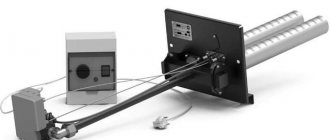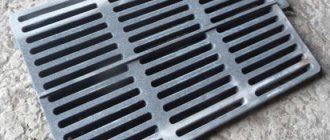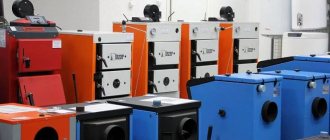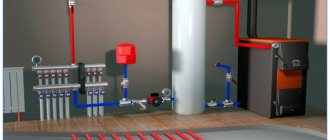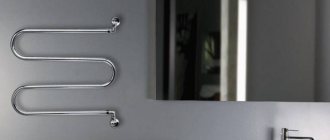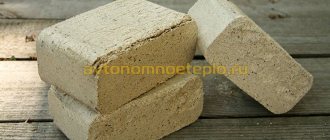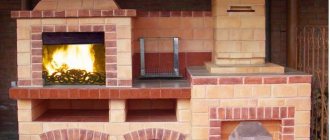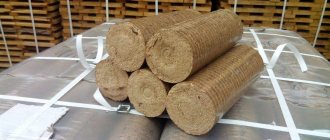The gas burner for the boiler is its most important component. The operation of the boiler, its efficiency and productivity depend on the choice of this component. The demand for such burners is quite high, since the type of fuel they use is considered one of the cheapest today. There is a wide range of gas burners. Therefore, in this matter you need to be careful and take into account all aspects.
What is a gas burner?
Gas burners for boilers are structures within which gas and oxygen are mixed. The mixture flows to the outlet holes and there ignition occurs from a spark or piezoelectric element and a stable, stable torch is formed.
The main task of the listed elements in boilers is to maintain stable and constant combustion of the resulting mixture. As you can see, the design of the boiler with a gas burner is quite simple and its installation will not cause difficulties.
A gas burner consists of several components: a nozzle, an ignition system, an automation system and a flame presence sensor.
Its structure must, first of all, be safe. In addition, this element of the heating boiler must burn the mixture without residue, and the release of harmful substances must be minimal.
Low noise level is another requirement for devices. You definitely need to pay attention to the service life.
Gas burners for heating boilers with automation are another safety requirement. As soon as the fire goes out, the fuel supply automatically stops. This is one of the main criteria for her selection.
They have found their application in household heating colas and in industry. Gas, despite its high consumer qualities, has a fairly low cost compared to other types of fuel. This makes gas burners in demand and popular.
Atmospheric gas burner.
Today, gas AOGV boilers - gas heating water heating devices - are of great interest. A distinctive feature here is the energy dependence of the boilers, that is, they can operate without an electrical network.
In addition, the noted devices are fully automated by the automated control system, which plays the role of an automatic temperature regulator and reduces the amount of fuel consumed.
Working principle and requirements
In the burner, the burned gas is combined with air. At high temperatures, chemical reactions occur. reaction producing carbon dioxide and water.
The process occurs with the release of heat energy. The energy heats up the coolant in the next working unit – the heat exchanger. Gaseous, liquid and solid substances are discharged into the street in one way or another.
What requirements must the burner meet:
- conventional design, reliability;
- long service life;
- low noise level;
- ease of switching from one fuel to another (if it is provided for in the boiler design);
- The low emission of nitrogen oxides and carbon monoxide during fire makes the boiler practically environmentally friendly. Of course, the chimney and exhaust pipe must be arranged correctly.
Classification of gas burners
The main types of gas burners: atmospheric/injection, blast/ventilation, and diffusion-kinetic. The first is characterized by an open combustion chamber. Air is supplied by being sucked into the gas flow.
Atmospheric gas burners consist of a tube or several tubes into which fuel is supplied. Low pressure is formed in the tube, due to which air is sucked from the room. Such burners are usually part of the boiler.
Most often, atmospheric gas burners are used for domestic heating boilers. The area that they can heat is no more than 100 sq.m. In addition, heaters can be used in boilers of various types - from expensive to cheap designs.
Blast gas burners for heating boilers have a more complex design and operating principle.
Ventilation burners have a closed combustion chamber. Here the air is supplied by a fan. Thus, it becomes possible to set the flow power of the gas-air mixture. This in turn leads to high efficiency values.
Blower burners must be purchased separately from the boiler, as an additional unit.
These burners for heating boilers have their advantages. Firstly, it is safety, since they have a closed combustion chamber. The second advantage is the high level of efficiency. Forced-air gas burners for boilers are insensitive to pressure changes.
They also have their drawbacks: high noise levels compared to atmospheric ones, high energy costs, and the high cost of the device itself.
As for diffusion-kinetic gas burners, they occupy an intermediate place between atmospheric and blast ones. Air is not completely supplied to the chamber, but is then added to the flame. They are not used in domestic boilers.
This type of burner has its pros and cons. The main advantage is considered to be achieving the maximum efficiency value. The disadvantage here is the high cost.
Classification by air supply method
This option depends on the design of the combustion chamber.
The combustion chamber can be open or closed.
In the first option, the air intake is performed directly from the room, and combustion gases exit through an ordinary chimney.
Another option implies that both air intake and smoke exhaust are carried out using coaxial tubes passing through through holes in the wall.
Low temperature burner
In open fireboxes, gas burners are used for heating boilers.
The working principle is simple: gas enters the wick through an ejector, air is drawn from the room by the heat generating unit.
Ignition is performed by small low-temperature flames. This type can be used in a wide variety of boilers, from conventional units of an old design to modern advanced models.
In addition to simplicity, low cost and versatility, gas burners have another advantage: low noise level.
Possibility of using ejector burners
If you have enough cash to purchase a multi-fuel boiler, you are lucky: two independent combustion chambers, you can switch from wood-fired heating to gas and vice versa without much effort (review of types of gas heating boilers for a private home). But multifunctional/universal boilers are not an economical option.
For example, you already have a wood chip boiler, and you want to convert it into a gas boiler - there are many options for automation, and there are fewer difficulties with the supply of fuel. Atmospheric burners for solid fuel heating boilers are in most cases atmospheric: the device is ordinary, there is virtually nothing to break.
Do-it-yourself atmospheric burners for heating boilers work on a similar principle. To use this device, you do not need to radically reconstruct the entire heating unit.
If, for example, you are converting a wood chip boiler into a gas boiler, you can use an ash pan to install the burner, and connect an automatic device from the outside for control and adjustment.
Atmospheric burners for outdated heating boilers of domestic production are also recommended to be purchased of the atmospheric type: the design features of such units do not make it possible to make the fuel chambers completely sealed, and therefore quite effective.
Some solid fuel boilers (for example, gas generator models) are already equipped with atmospheric burners for ignition.
Pressurized burner (pressurized)
In closed fireboxes, free flow of air to the wick is impossible, so they resort to artificial injection. The combustion chamber includes a built-in fan that forces air into the chamber forcibly.
This burner is not as versatile as the previous one, but it has another advantage: it is easier to integrate into a fully automatic boiler control system (about heat supply schemes for a private house with a gas hot water heater).
The fan burner multiblock includes the following parts:
- gas filter;
- pressure regulator;
- flow regulator;
- gearbox;
- relay for turning off and forcibly turning on the burner when pressure drops/increases;
- fan relay (turns off the burner when the fan motor stops).
It is best to have an uninterruptible power supply in the system in case of a sudden power outage.
The disadvantages of this type of burner are high price and complexity. Boilers for them need to be completely reconstructed; they are not suitable for all units.
Other differences
In addition to the above, depending on the type of adjustment, there are other types of gas burners. These include single-stage, two-stage, smooth two-stage, modulated.
The structure of a gas burner.
The operating principle of single-stage gas burners is to automatically close the gas valve as soon as the coolant reaches a certain temperature. Thus, the gas burner automatically goes out.
After the gas reaches the temperature of the lower limit, the gas valve automatically opens, which leads to the complete ignition of the burner. Such devices are very convenient to use in gas household appliances.
Two-stage gas burners for the boiler operate in two systems - 40% and 100%. The burner starts working at 40% immediately as soon as the coolant heats up to the desired temperature and the gas valve is closed. The automatic system allows you to switch from one work system to another.
Smoothly adjustable two-stage gas burners operate in two modes. Here the transition to another mode is carried out more smoothly than in two-stage ones.
When heating the boiler continuously, modulating burners are used. Unlike a boiler with an atmospheric burner, this type of burner covers a wide power range. In addition, modulating options significantly save gas.
Due to the automation of the process, the service life of such units is much longer. The flame height in a gas burner for modulating heating is automatically adjusted.
In turn, modulated options are classified depending on the operating principle of the modulating units.
There are burners with modulation:
- mechanical;
- pneumatic;
- electronic
Burners with electronic modulation provide high precision control. Today, modulating gas burners made in Italy are considered the best.
Types of atmospheric burners for heating boilers
Here you will know:
The heart of any gas boiler is a burner with a heat exchanger installed above it. The burner burns gas fuel, creating heat. For its part, the heat is absorbed by the heat exchanger and sent to the heating system. The current review will be devoted to the burners themselves.
We will tell you what an atmospheric burner is for a high-pressure boiler, and we will also give information about the types of burners for gas-fired boilers.
Types of universal boilers using a gas burner
Let's look at the example of a universal wood-coal-gas boiler. Such boilers use an atmospheric gas burner, where gas and air are mixed naturally. You can also use a blower system equipped with a fan.
Which one to choose is up to the buyer, but it should be mentioned: fan models are volatile and noisier.
An automated gas burner is performed using a fan circuit. Gas and air are mixed in it, after which the resulting mixture enters the nozzle and ignition occurs.
Design features of the burner for a gas boiler.
A fan, gearbox and automation system are built into the burner side, with the help of which the gas burner is adjusted.
Today, the most famous are universal gas/diesel boilers, since the structure of these substances during combustion is very similar. This makes switching to another fuel quick and easy.
There are also more expensive models of universal boilers that operate on many fuel options. For example, boilers: wood-coal-electricity-gas-liquid fuel. There is only one type of fuel here. It is on this basis that the boiler power is calculated. Accordingly, other types of fuel are secondary.
Using a liquid fuel element will reduce the efficiency of the heating equipment. When heating firewood, diesel, briquettes, the heat rises from the bottom up and heats the coolant. If a burner is used, it spreads horizontally.
As a result, the rear wall of the boiler is exposed to the greatest heat. After long use it may burn out.
Additional thermal insulation will help solve this problem. Diesel fuel must be stored in appropriate places. These include plastic containers and rooms with a protective tray. Sometimes it is buried next to the boiler room, if the soil allows. The issue of storage should be thought out in advance.
Universal boilers are often used in car repair shops. If the object is located in a place without access to a gas main, then universal heating devices will be an excellent choice.
Not only wood, coal or pellets, but also used oil can be used as fuel. This fuel provides fairly high efficiency.
At the same time, consumption can vary significantly depending on power. A sufficient supply of this material is required, which is only possible with large-scale turnover.
Switching from heating one type of fuel to another is sometimes simple, and sometimes labor-intensive. Changing from diesel to gas can be particularly dangerous. The first, as a result of prolonged operation of the heating system, leaves soot in the chimney.
After switching to gas, it may crumble and block the chimney. Then carbon monoxide can enter the room, which is fraught with serious consequences.
Of course, in this case the burner should turn off automatically. Nevertheless, it is not worth risking your life and it is better to turn to specialists. They will definitely clean the chimney after changing the heating operating mode.
All the above transition conditions are characteristic only of single-fuel systems. Their design involves burning fuel in one chamber. On the one hand, such a device is the most economical. If you do not plan to change modes frequently, then there is no point in overpaying.
Based on the materials used, boilers are divided into cast iron and metal. The first option is the most reliable. Their design allows them to withstand severe thermal loads. They are able to provide a long service life even at high operating powers.
The disadvantage of the devices is their bulkiness and weight. When choosing, it is necessary to think in advance about all possible options for operating the specified heating device.
Double-furnace boilers are more practical and easier to use. Especially when it comes to frequent switching from one type of fuel to another. At the same time, they have significant dimensions. The fireboxes in them can be located in different ways: next to each other, one above the other.
In this case, the same coolant circuit is heated by different types of fuel, and the transition is carried out without additional installation work, manually or automatically, depending on the additional equipment used.
Installation of a gas boiler with a burner.
Each compartment is made specifically for a specific type of fuel. The result is high efficiency and cost-effectiveness due to changing operating modes. Switching from one work option to another does not cause any difficulties. In some models it can be done automatically.
These heating systems are especially effective in conditions of power outages, unstable gas supply, and the high cost of connecting to the main line.
Given the availability of solid fuel materials and their relatively low cost, they have no equal. On the other hand, the price of a universal system is quite high.
Variety of burners by ignition type
The simplest method of ignition is considered to be with a wick - with a burning igniter. When the automation is triggered, the gas is ignited with a wick, after which the device begins to heat the liquid. There are two negative aspects to this - increased fuel consumption and an insufficient degree of safety, since the igniter may go out. Primary ignition is performed with matches or using a piezoelectric element.
The second method is electronic ignition in a gas appliance - it is provided by a high-voltage converter, the energy for which is supplied by electricity or batteries. Read also: “How a gas burner for a stove works - types, advantages of use.”
The first method is used in non-volatile devices - they do not have electronics, and the second option is when automatic gas burners are used for heating boilers. In this case, in addition to electronics, flame ionization control modules are installed on board.
Different types of fuel can be used to ignite the burner. The natural gas supplied from the main line is purer; it is supplied at optimal pressure, so the flame in the device does not smoke. Such boilers are connected to the network without making any modifications.
There are burners on sale that can operate on propane. This will require reconfiguring the system and installing the nozzle. When burned, the flame gives off a yellow glow, and there is an increased deposition of soot on the walls of the chimney. The jets normalize the propane pressure to a normal value; they are supplied as a kit or purchased.
Homemade units
There are craftsmen who remake heating systems with their own hands. On the Internet you can even find the necessary diagrams for changing the devices of gas burners, their installation and adjustment.
Typically, metal is used as a material for the manufacture of heating systems. A cast iron firebox would be much more reliable. However, it is not possible to use it at home.
An excellent option for manual work is to order the system from specialists. They will be able to manufacture the device in accordance with all the customer’s wishes. However, the possibility of defects in the boilers cannot be ruled out, which may appear after some time.
Why do you need homemade heating units? The fact is that the marked options have a lower cost. They are made mainly because of the desire to save money. At the same time, these options are inferior to their factory counterparts in efficiency.
Over a long period of operation, it may turn out that the homemade option will be even more expensive.
Usually only solid fuel and electric units are manufactured. Making a gas or diesel boiler is extremely dangerous. In addition, their installation in the house is strictly prohibited.
According to the principle of operation, a homemade product is no different from a purchased version. It will burn fuel and heat the coolant filled with water.
The main disadvantage of this unit is the lack of warranty. Factory equipment will work and perform its functions. Even if the buyer stumbles upon a defect, he will be able to exchange the product for another.
It is better to use pellets, firewood, and coal as fuel in self-made units. These materials are less dangerous than gas. It is impossible to make heating devices based on the latter.
Simple solid fuel units are the most popular and widespread homemade devices. They are simple, and their design is in many ways similar to a conventional stove. In addition, they are versatile.
Like a conventional stove, these systems can operate on any solid fuel. The main thing is that it burns.
Main parts of a gas boiler.
The efficiency of homemade equipment is significantly lower than factory equipment. It is influenced by many factors.
Among them:
- thermal insulation;
- combustion completeness;
- the correctness of the conclusions.
The efficiency of the unit directly depends on the combustion temperature. The higher it is, the lower the efficiency. In high-quality systems, the temperature in the firebox is maintained at 120–150°C. Higher values reduce the safety of pipes. This in turn significantly reduces the durability of the unit.
When manufacturing heating boilers with a burner, it is better to protect yourself as much as possible from the possible consequences of its operation. Therefore, you should consider a separate purchase of an automatic gas burner, which will be installed in an atmospheric or blown boiler.
You can also make electric heating units with your own hands. Their design may vary. It all depends on the person’s needs. The simplest option is to install a heating element directly into the heating system. In this case, there is no need to make a boiler.
The pipe with the heater must have a sufficiently large diameter. It should be easily removable for repairs and cleaning.
Systems without a heater deserve special attention. Its role is played by water itself. A current is passed through it, and heating occurs due to the movement of water ions. The liquid itself must contain salt.
It is extremely difficult to make such a device. Electric current passes directly through the coolant, so the entire system must be reliably insulated.
One of the dangers of this device is electrical breakdown. Essentially the same as a short circuit. Gas may also accumulate in the system. As a result, heating efficiency will decrease.
From all of the above, the best option is a solid fuel unit. Its body can be assembled from heat-resistant steel. It is characterized by increased strength, less wear and high resistance to thermal influences.
However, heat-resistant steel is expensive and in practice is rarely used in homemade boilers. Another option is cast iron: this material tolerates heat well, although it is difficult to work with. Equipment for the manufacture of cast iron stoves is available only at specialized enterprises.
It is important to understand that without the proper experience and skills, it is better not to make a heating system yourself. Safety must come first. It is enough to make even one inaccuracy, and this can lead to disastrous consequences.
Application Specifics
Atmospheric burners are easy to maintain. The main feature is annual cleaning. In this case, the procedure should be carried out exclusively by experts in their field, since this requires dismantling the boiler. Very often, the warranty center is responsible for cleaning the burners.
Dirt can be easily removed using compressed air. It is important to set the appropriate pressure. But the thing is that some modern parts most likely will not withstand a flow of 10 atm.
To make the cleaning process quick and less frequent, a specialized filter is installed on the gas supply. This is performed by a specialist after submitting an application to the required structure.
Well, despite the fact that an atmospheric burner in a heating boiler, although it seems like a very complex engineering unit, is no less easy to create with your own hands. To do this, you need to prepare all the accompanying materials and have experience working with metal. Moreover, you need to have several units of special tools.
Bottom line
Gas burners have found their application in household heating systems, as well as in industry. Gas, despite its high consumer qualities, has a fairly low cost compared to other types of fuel. This makes gas burners in demand and popular.
This review discusses the main types of gas burners, their advantages and disadvantages. This information will definitely be useful when choosing a boiler for heating, taking into account the place of its use: house, apartment, cottage.
Classification by type of fuel
The gas boiler will operate on natural (main) methane gas or liquefied gas from cylinders (propane-butane). At this time the difference in price is insignificant.
Since in conditions outside the city it is not always possible to connect to the main line, you will most likely need a propane or butane atmospheric burner for your heating boiler.
Structurally, these boilers are the same; the burners have their own small parts. Burners for real and liquid gas are distinguished by the design of their spray devices. Many units are equipped with spray devices for two types of fuel.
As a result, atmospheric burners for propane heating boilers can be easily reconfigured to work with main gas and vice versa.
Proper care is the key to long-term operation
During operation, the gas burner needs timely cleaning of soot. It appears during operation and, if accumulated in large quantities, can lead to sudden ignition. A scheduled inspection of the equipment and regular maintenance of the heating device and gas burner will help you avoid troubles.
If you are cleaning it yourself, we recommend that you read the included instructions. But a more prudent decision would be to contact specialists who have experience in this field. In this case, the work will go much faster and better, with the least amount of dirt.
Examples of boiler houses based on gas boilers ICI Caldaie
Steam and water heating boiler room for a dairy plant
Chebarkul Dairy Plant
Steam and water heating boiler room for food production
Meat processing plant "Tavria"
